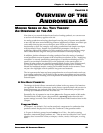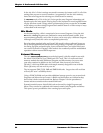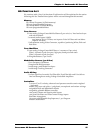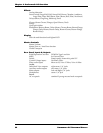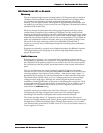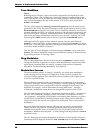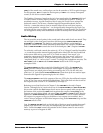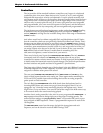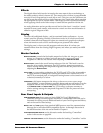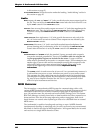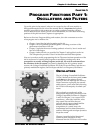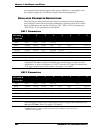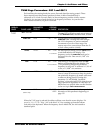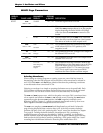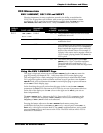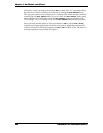
Chapter 4: Andromeda A6 Overview
ANDROMEDA A6 REFERENCE MANUAL 101
Effects
The digital effects built into the A6 employ the same state-of-the-art technology as
the studio products Alesis is known for. The extensive list of effects is programmable
not only for each Program but for each Mix as well. This gives you the freedom to set
up effects sets that work well for a single Programs, then create other effects sets that
are appropriate for split or layered Mixes. This design provides enormous flexibility
when applying effects to the wide variety of sound textures possible with the A6.
An analog distortion section provides several levels of the classic "overdrive" sound
essential to many synth sounds, with extensive control over how much distortion is
added to a given Program or Mix.
Display
The 240 x 64 backlighted display – and its associated knobs and buttons – is your
control panel for operating virtually all functions on the A6. It is both a text-based
window where titled and numerical values are entered and a graphical workspace
where A6 functions such as LFOs and Envelopes are pictured when edited.
The display area is where you edit programs and store them. It is where you
assemble Mixes from the existing single Programs, and where you make your MIDI
settings.
Master Controls
MASTER VOLUME: controls the final audio output level of the A6. Any pre- or post-
mixing in a Program or relative levels set among the component Sound
Programs in a Mix are not affected when adjusting the
MASTER VOLUME.
MASTER TUNE: controls the overall tuning reference of the A6. This knob is used to
tune the A6 to another instrument. Any VCO tunings, transpose amounts or
relative tunings among the component Programs in a Mix are preserved when
adjusting the
MASTER TUNE.
AUTO TUNE: as a true analog synthesizer, the 32 VCOs and VCFs of the A6 are subject
to slight amounts of tuning drift. Pressing this button twice retunes the VCOs
and VCFs to standard pitch. A background tuning feature can be turned on or off
as desired; normally it is left on.
TRANSPOSE: this button transposes the A6 up or down over a two octave range.
Using Middle C as your reference, press this button and use soft knob
1 to set the
transpose amount. The A6 will be globally transposed by the new interval. As
with
MASTER TUNE and AUTO TUNE, any VCO tunings, transpose amounts or
relative tunings among the component Programs in a Mix are preserved when
transposing.
Rear Panel Inputs & Outputs
RAM EXPANSION CARD slot: accepts an Alesis PCMCIA Type I SRAM card for
additional storage of both Programs and Mixes. A compatible RAM card can be
formatted for storing several additional banks of your own Programs and Mixes,
and can be used for data backup.
MIDI IN, OUT and THRU ports: these standard MIDI ports are used for communication
between the A6 and other MIDI-compatible devices. A thorough discussion of
the MIDI functions of the A6 can be found in Chapter 8.
FOOTSWITCHES AND PEDALS: see the discussion under the heading “Controllers”
earlier in this section on page100.
CONTROL VOLTAGE INPUTS: see the discussion under the heading “Controllers” earlier



